Elevate Your Game with 5 Incredible Aquarium Standouts
Elevate Your Game with 5 Incredible Aquarium StandoutsWhat are some unusual aquatic life? There are many unusual aquatic life found in freshwater and marine waters around the world, but not all are suited for life in an aquarium. With this article, let’s explore five that are able to live in an aquarium environment and bring a lot of satisfaction to aquarists if their care requirements are met. Let’s start with two saltwater fish that deserve to be on the list of aquarium standouts. The Red/Orange Anglerfish – saltwater fish 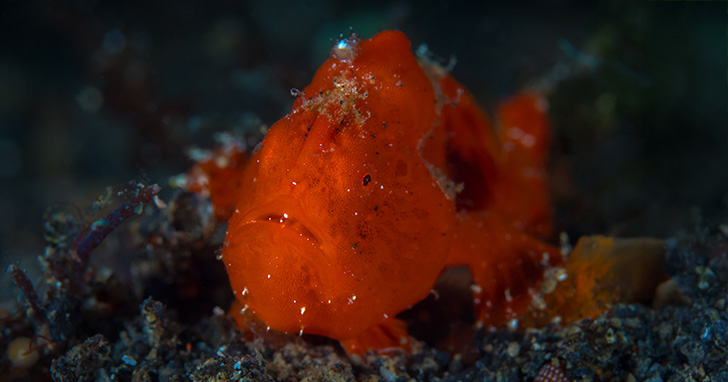
The Red/Orange Anglerfish Antennarius sp. is found in nature among the Indo-West Pacific region of the world among sheltered rocky reefs up to about five meters deep. The Colored Anglerfish can range in color from a vivid red to deep orange, often changing color to blend with their surroundings. Their care requires that of a dedicated and experienced aquarist. They are categorized as semi-aggressive and reef safe with caution because they can feed on small fish and ornamental crustaceans that they lure into their mouth with the use of an esca (modified first dorsal spine) that looks like a small, tasty fish. They can grow up to nine inches and should be kept in an aquarium of at least 30 gallons or larger with large amounts of live rock they use as shelter. Water parameters should be maintained as follows: sg 1.020-1.025, 72-78° F, dKH 8-12, and pH 8.1-8.4. Red/Orange Anglerfish are endearing because of the way they move. They are a more sedentary ambush predator, but when they move, they hover instead of swimming, resulting in motion that looks more like walking than swimming. Caretakers should know that this saltwater fish has a sensitive air bladder that dictates that they are not exposed to air during transfer in and out of water, or during shipping. This member of the Antennariidae family is a carnivore that will accept most meaty meals including feeder fish, which is also a good option during acclimation. The Two-Fin Flashlight Fish – saltwater fish 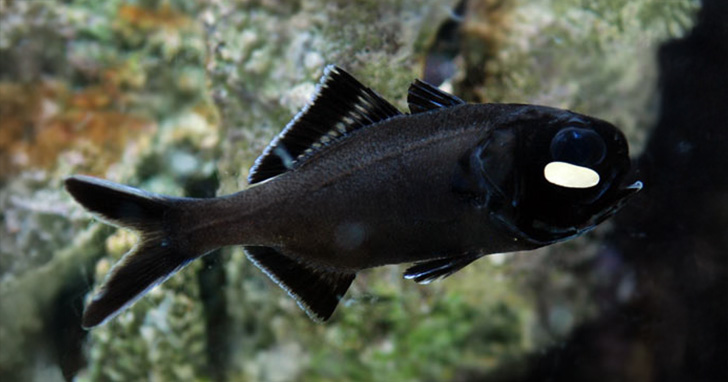
The Two-Fin Flashlight Fish Anomalops katoptron casts a dazzling display in saltwater aquariums and is recognized by their black body that has a blue hue to its dorsal and caudal fins. It has what appears to be a glowing smile due to the bioluminescent bacteria that inhabit the light organs found just below each eye. These symbiotic bacteria are responsible for its glow, which is usually white but occasionally blue or yellow depending on the mood of the fish. These fish have an amazing ability to rotate the light organ within its socket in order to turn the light on and off. The light organ of the Two-Fin Flashlight Fish is used in several ways. The most common use is to communicate among themselves by increasing the frequency of the blink. Another use is in the form of defense, turning the light on, and then quickly off while darting away from a predator. The last use for their light is to attract food in the form of plankton as these tiny crustaceans are normally attracted to light. Designated as an expert only marine species, this nocturnal fish is well suited for the specialized aquarium that contains other nocturnal fish. A dimly lit aquarium with numerous hiding places is ideal. Best when kept in small groups, they are rarely aggressive among themselves or to other fish in the aquarium, and fares best when housed with other passive tankmates. It is classified as reef safe with caution. Growing to about nine inches, an aquarium with a minimum capacity of one hundred twenty-five gallons is recommended. Water parameters for this unusual specimen are as follows: sg 1.020-1.025, 72-78° F, dKH 8-12, pH 8.1-8.4. These fish are extremely sensitive to copper sulfate and should never be exposed to this medication. This member of the Anomalopidae family is a carnivore that should be fed zooplankton and crustacean meats. In addition to the two marine fish listed above, two freshwater fish and an amphibian make the cut in our unusual specimens list. Let’s learn more about them. The Albino Axolotl – freshwater amphibian 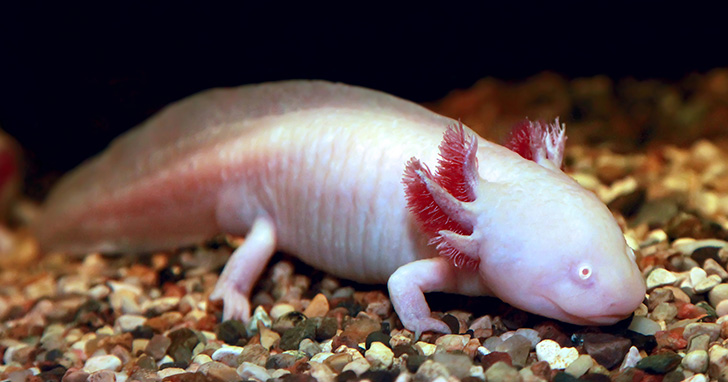
Let us discuss the features of the Albino Axolotl, GFP Ambystoma mexicanum. These peaceful freshwater amphibians are part of the Ambystomatidae family and are known for their unique look. Because they lack a thyroid stimulating hormone, they do not undergo metamorphosis, so they retain a larval look throughout their lifetime. The Albino strain results in a pinkish white coloration. Where does their name come from? They are named by Aztec Indigenous people and “Axolotl” come from combining two words: “atl” (meaning “water), “xototl” (meaning “dog”). “GFP” in this particular species’ name refers to Green Fluorescent Protein, which causes them to glow green under certain types of lighting. Reaching an adult length of nine inches, these peaceful nocturnal amphibians can live up to ten years. The reason for their longevity is most likely because they have the ability to regenerate many body parts including limbs and tails, as well as organs such as their central nervous system, tissues of the eye, heart, and parts of their brains. Axolotls require experienced caretakers due to their difficult care level. They need cooler water in which to live, as warmer temperatures can cause stress, which makes them more susceptible to infections and disease. Aquarists should select an aquarium of at least twenty gallons for one specimen. Because they spend a majority of their time at the tank bottom, special care should be taken when selecting the tank substrate. Gravel should not be used; the substrate should consist of smooth sand with grain particles under 1 mm because bowel obstructions are a common cause of death. It is recommended to keep Axolotls in a species-only aquarium. Water parameters for the Albino Axolotl are as follows: temperature range of 57-70° F, KH 8-12, and pH in the range of 6.0-7.5. An unusual carnivore that does not have teeth, Axolotls suck or vacuum their food into their stomachs. In captivity, they will eat a variety of readily available foods including appropriately sized soft pellets, frozen or live bloodworms, earthworms, and waxworms. The Blind Cave Tetra – freshwater fish 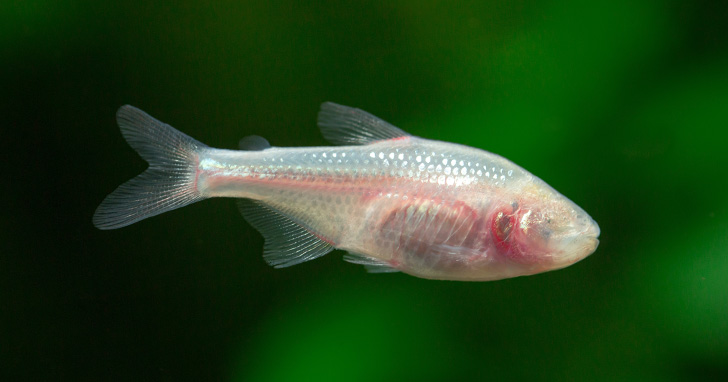
The Blind Cave Tetra Astyanax mexicanus is one of the most unique freshwater fish available to the aquarium trade and are good for beginner aquarists because they are peaceful and have an easy care level. In nature they live in caves along the lower Rio Grande and Pecos Rivers in the United States, and south through eastern and central Mexico. The Blind Cave Tetra is born with eyes, but, since they are not needed, are reabsorbed into their bodies after birth. Due to their absence of sight, they have well developed hearing and use their lateral line to detect water pressure changes, allowing them to navigate and locate food. They also maintain a memory map of their surroundings. For this reason, tankmates should be chosen with care. Because they are blind, they may bump into others while feeding, which shy or sluggish tankmates may interpret as aggression. A true cave inhabitant, they present themselves in a pinkish white color due to their lack of pigmentation, with their scales getting an iridescent quality as they mature. An aquarium size of twenty gallons is sufficient for a small group of four or five, as they like to be with others of their own species. Blind Cave Tetras will make themselves at home in any environment but for those wishing to replicate their natural environment, a dark substrate of sand or small gravel and low lighting as well as slate or rocks along the back and sides of an aquarium will help them feel at home. Décor and plants are unnecessary. Water temperatures in the range of 68°-77°F and pH balance in the range of 6.5-8.0 is recommended, as well as KH in the range of 4-8. A prolific breeding species, females are egg layers and are easier to identify as they are rounder than their male counterparts. To keep eggs safe from predation, a breeding pair can be moved to a separate tank that has a substrate to protect the eggs (such as marbles or smaller rocks) that the eggs fall beneath. A sponge filter is recommended for the spawning tank to protect the fry. Females can lay as many as 1,000 eggs that will hatch within 24 hours and the fry will be swimming within a week. This member of the Characidae family is an omnivore that will root in the substrate for food and can accept a variety of foods including sinking pellets, frozen foods, live foods, flakes, and granules. Koi – freshwater fish 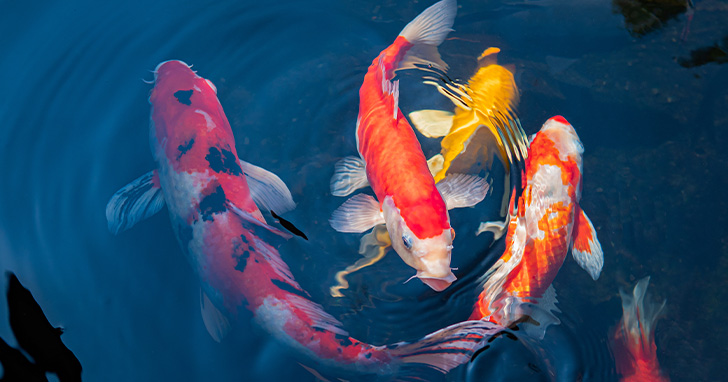
Koi fish are undoubtedly the longest genus of fish kept in the aquarium trade. Thought to originate in the Middle East from common carp, they were widely traded as a food source and were exported to Japan, China, and Western Europe. These brown fish occasionally produced red and blue mutations, and Japanese breeders began selective breeding them to produce red and white varieties, the first of which emerged as the modern ornamental Koi fish around the year 1870. Since then, more than 100 color varieties have been bred. Entire strains of High Quality Koi fish have been produced by top Japanese breeders, breeding show champions with specific physical characteristics. They are bred for specific sizes, patterns, colors, and behavior. These High Quality Koi are now offered by quality suppliers such as LiveAquaria®, enabling aquarium aquarists the opportunity to house. While some Koi have been known to live longer than one hundred years, their typical life span is twenty-five to thirty-five years. They are good fish for beginner hobbyists due to their easier care level and peaceful temperament. So as not to inhibit their growth, the ideal setup for Koi is a pond of at least one thousand gallons with a fine gravel substrate, rocks and hardy plants. Koi like to eat the roots of plants and will dig to get to them, so be sure to anchor and protect plants by placing large rocks around their bases. Also, there should be adequate filtration to maintain proper water conditions. Koi should be fed a quality pellet or flake food with a protein content that does not exceed 30%. In closing Creating an aquarium that has interesting, colorful aquatic life is the reason most of us joined the fishkeeping community to begin with. When we source fish and other aquatic inhabitants that elicit a favorable response from our family and friends, it is a reward for all our hard work. When you add one of these spotlight species or any of the others available to your home aquarium, it reinforces our love of the aquarium hobby. Related Articles |
|
|


